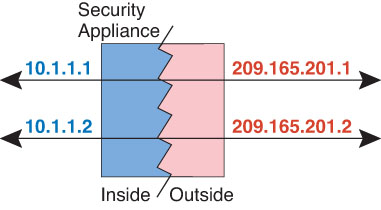About Static NAT
Static NAT creates a fixed translation of a real address to a mapped address. Because the mapped address is the same for each consecutive connection, static NAT allows bidirectional connection initiation, both to and from the host (if an access rule exists that allows it). With dynamic NAT and PAT, on the other hand, each host uses a different address or port for each subsequent translation, so bidirectional initiation is not supported.
The following figure shows a typical static NAT scenario. The translation is always active so both real and remote hosts can initiate connections.

Note | You can disable bidirectionality if desired. |